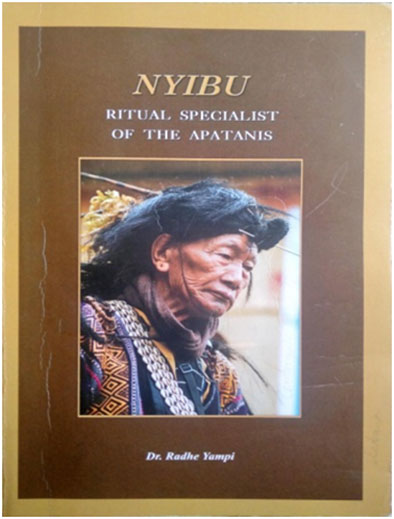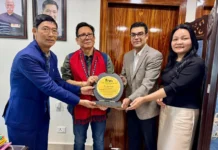Nyibu ritual specialist of the Apatanis
by Dr Radhe Yampi
Pages: 230
Price: Rs 450
[ Yater Nyokir ]
Nyibus are believed to be gifted with the power to heal, soothsay, know and see the unknown realm of the spirit. A nyibu and his world blended with mysticism, mythology and supernatural phenomenon is always an enigma for mankind. Nyibuship is an ancient and widespread practice among the tribals of Arunachal Pradesh. As a voyager of two worlds, a nyibu is a central figure in all the traditional rituals. All these conundrum environs of nyibus are what make them incredibly fascinating, not only for the laymen but also for researchers and academicians.
Since long, the directorate of research of Arunachal Pradesh has been doing a tremendous job in upholding its objectives, ie, to preserve and promote the culture of the state. To uphold its objectives, the department is engaged in documenting the annals of the unwritten past and the fading traditions of the state. Dr Radhe Yampi’s book, Nyibu ritual specialist of the Apatanis is one such effort by the directorate of research. It is an endeavour to comprehend the core element of the Apatani culture of nyibu. The book claims, “Nyibus are central functional figures in the arena of Apatani religion.” “…right from the birth of an individual to death; economic pursuits to the larger political system, the guidance of nyibu is sought in all realms of community life.” Unfolding the magical odyssey, the book is a compendium of eight chapters. Each chapter broadly and effectively touches all the facets of the nyibu’s cosmology, starting from its origin to negotiation with gradual change and transformation.
The author calls a nyibu a ritual specialist rather than a shaman or priest. The author writes that nyibus neither fall into the category of priest nor shaman absolutely but share the characteristic of both. Therefore, it has its unique identity. “The term nyibu itself is must appropriately to refers to such an institution.” The bottom line of the book is that it finds an answer to the question as to why the nyibus are held in high regard in the Apatani society.
I found that the most interesting part of the book is transcription and translation of invocations and chanting performed by nyibus in various rituals. This offers an understanding of the ifs and whys of ritual ceremonies that are held for various purposes. Tucked in Chapter 7, the well-documented case studies concerned with the impact of alien religious ideologies upon the institution of nyibu, filled with personal experiences of respondents, is another interesting read. It offers an insight to understand the trend of change and continuity of the institution of nyibu, especially in the Apatani community.
While the striking cover page permeates the layout of the book, each flip echoes the wisdom and experience of the author. The book is deeply researched and provides an overview of practices and precepts of nyibuship. The only lapse is, although the book offers a full view of the rich and interesting details of the subject, it is confined only to the Apatani community. Though all the tribes of Arunachal Pradesh have reference to nyibu or equivalent figure, each tribe has its uniqueness. Therefore the book may disappoint the reader who is on an errand to know about nyibus in general. Otherwise, the book is a classic ethnographic account of the dynamics of nyibu, which may appeal to scholars and laypersons alike. It can also be a helpful reference and resource tool for ethnographic and anthropological studies. (Yater Nyokir is a member of the Arunachal Pradesh Literary Society and a PhD scholar in the English department of Rajiv Gandhi University.)





